Think about growing fresh vegetables in fall and winter… Did you know that with a little extra TLC you can harvest fresh food throughout a chilly fall and winter? Here I explain extending your gardening into the colder months. Depending on where you live and how cold it gets, there are possibly many cold-season crops you can grow.
Remember, food-producing plants will need a minimum of 6 hours of direct sunlight per day. Choose a sunny spot to plant.
Winter gardening is especially easy if you live in a very hot climate, like zone 9b where I live (includes parts of southwestern United States), where it’s almost too hot and too much work to keep things thriving in June – August. It’s easy for me to grow in the fall and winter months. I sow seeds directly into my garden bed and planters; no transplanting needed!
Keep reading to learn about importance of soil temperature and hardiness zone, what you can grow, info on planting, structures to keep your plants warm, succession planting, winter garden care, and more.
In many areas, fall and winter vegetables are easy to grow. Extending your gardening in the colder months means you can grow almost all year long.
Cool Season vs Warm Season Crops
A good way to think about the difference between cool season (fall, winter, spring) and warm season (summer) crops is how warm the soil temperature needs to be for the seeds to germinate or for transplanting.
In general, 50° F is a good rule of thumb for cool-season crops.
Cool season veggies like broccoli, peas, beets, cabbage, kohlrabi, kale, lettuce, Swiss chard, carrots, radishes, onions, spinach, turnips, and onion have chances for successful germination when the soil is around 40 to 50 F.
Peas germinate at cool soil temperatures around 40° F. Lettuce, spinach, and parsnips can germinate when soil is 35° F, but prefer around 45° F.
Compare this with warm-season crops such as beans and tomatoes. They do well in soil that’s around 55° F. Peppers, sweet potatoes, and melons need soil temps of around 60° F.
How to Measure Temperature of Soil
Buy a soil thermometer from a hardware store, home improvement center, nursery, or garden center. Experts recommend measuring soil temperature in the late morning (10 – 11am) for several days to get an average. They recommend measuring 2 ½ inches deep.
- Put thermometer probe in soil, 2 ½” deep
- Mark results in phone or on paper
- Test different spots in your garden, especially in shadier areas
- Repeat at the same time for 4 – 5 days to get average temperature
- Before planting, check weather forecast to be sure there isn’t a cold snap forecasted
If you plant seeds or transplants in soil that’s too cold, they might not root well and could even rot.
Which Plants to Grow in Fall and Winter
These are cold-tolerant plants that you may be able to grow in your area:
Brassicaceae (Cruciferous) also called cole crops:
- Broccoli: Can survive light frosts; prefers cooler weather
- Brussels sprouts: Known for improved flavor after frost
- Cabbage: Tolerates frost; can be grown in cool temperatures
- Cauliflower: Grows best in cool temperatures
- Kale: Very cold-hardy; can survive freezing temperatures
Alliaceae also called the onion family:
- Garlic: Planted in fall for a summer harvest, tolerates cold
- Onions: Can be planted in early spring or winter in warmer climates, tolerates cooler weather
Apiaceae also known as the carrot or umbellifer family:
- Carrots: Tolerates frost; cold enhances sweetness
- Parsnips: Very cold-hardy; frost improves flavor
- Celery: Prefers cooler temperatures
Asteraceae also called daisy family:
- Lettuce: Prefers cooler temperatures; tolerates light frost
- Endive and radicchio: Cold-tolerant, grows well in fall and early winter in many areas
- Artichoke: Can grow as a perennial in areas with mild winters
Amaranthaceae also called amaranth or spinach family:
- Spinach: Very cold-hardy
- Swiss chard: Tolerates frost and cold
Chenopodiaceae is also called the goosefoot family:
- Beets: Frost-tolerant, the root can survive ground freeze
- Turnips: Roots and greens are both frost-tolerant
Choosing Seeds vs Starts
Plant seeds when you are growing root vegetables. If you go to your local garden center or nursery, you will find starts for leafy greens and other plants that will grow well in your area.
I’ve had luck planting everything from seed, and do well with them every year. The exception is my carrots. When I water them consistently, they do better. (I’m in a dry climate.) Be sure to plant in well-draining, nutritious soil.
There are some crops that do better when you plant the seeds directly into the garden without transplanting. These are:
- Arugula
- Beets
- Carrots
- Mustard
- Radishes
- Turnips
Where Do You Live? Know Your Zone
To me, remembering first and last frost dates is confusing and stressful. I think it’s much easier to learn, remember, and apply your USDA hardiness zone to what you plant and when to plant it.
If you don’t know yours, check what it is, then come back here and keep reading where I’ll explain what you can plant.
Your zone will have an ‘a’ or ‘b’ subcategory after the number. Knowing this will help you further drill down when to plant but for now, it’s enough to have a general idea, without the a or b.
In areas with mild and moderate winters, you can grow many plants year round out in an open garden
Milder climates (USDA Zones 8 – 11):
These areas have mild winters and rarely experience hard freezes. With nutritious soil and proper watering, you can have a successful fall and winter garden in these zones.
In Zones 8 – 9, you can grow a good variety of cool-season crops like:
- Carrots
- Spinach, kale, butterhead lettuce
- Radishes
- Beets
- Cabbage
In Zones 10 – 11, temperatures are even milder. You can continue growing warm-season crops like tomatoes and bell peppers well into the winter months.
Moderate climates (USDA Zones 5 – 7):
In these zones, winters are colder than in milder climates but not as harsh as in the coldest zones.
As an example, gardeners in Zone 5 can plant hardy root vegetables and leafy greens because they can handle light-to-moderate frosts.
Harsher climates (USDA Zones 1 – 4):
Winter gardening is challenging in these zones. This is due to the snowfall and cold. Even backyard greenhouses are not usually worth the trouble due to the continued freezing temperatures.
You may be able to grow a few things. For example, in Zone 3, it’s possible to grow very hardy vegetables like kale and Brussels sprouts because can tolerate frost.
Cold frames and mulching can be helpful in these zones, extending the growing season and protecting plants from the cold. More on this below.
General Guidelines
- Focus on root vegetables and leafy greens
- Start with mature plants called “starts” if you can find them at your nursery
- When selecting varieties, look for words such as “cold tolerant” and “cold hardy”
- Sow seeds directly in the ground without transplanting for carrots, turnips, radishes, and other root veggies
- Plant in a sunny, accessible site
- Protect plants when temperatures are unusually cold for your area
Many root crops may be left in the ground, mulched well, and harvested as needed throughout the winter. This means, instead of storing them, you can pick as you need them.
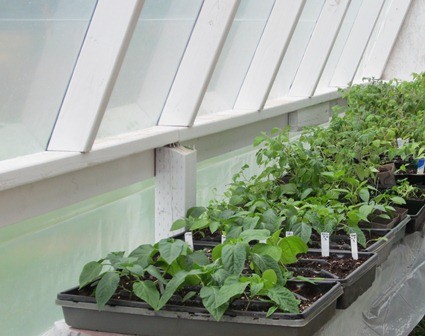
Hardy vegetables such as carrots, kale, leeks, and mâche may need nothing more than poly hoops.
Less hardy vegetables and herbs may require a cold frame to continue providing fresh greens for several weeks or months.
Perennial herbs (sage, rosemary, thyme) may remain green longer in this environment, delaying dormancy.
Consider a heated small greenhouse as another way to garden in the cold months.
When to Start Seeds
In colder climates, plants should reach maturity before cold weather sets in. Some will continue to grow in protective structures; others will be in a “holding pattern,” maintaining their freshness until harvest.
Seeds should be planted well before the average date of first frost. When time is short, select varieties that mature quickly.
Ideal last sowing date for a specific vegetable:
If you don’t already know it, find the average date of first autumn frost in your area. Note the number of “days to maturity” listed on the seed packet or catalog info.
Add an extra 10-14 days to account for fewer hours of daylight in late summer and fall (seed packet info is based on spring/summer planting).
On a calendar, start with the average date of first frost in your area and count backward to reach the optimal planting date.
Example: My packet of mesclun (mixed greens) seeds indicates the plants are ready to harvest in 28 days. I add on 14 days because I’m planting them in the late summer.
Starting with our average first frost date of September 15, I count back 42 days and land at August 4, the ideal planting date.
I may plant a little later than that, knowing that the seedlings will be nearly mature when the first frost hits. I can cover them with a protective material as that time approaches.
Where to Plant
Accessibility is the first factor to consider, as winter veggies will do you no good if you can’t reach them. Many people like to site their structures near the house or a path that is well-used even in winter.
Root crops buried under deep mulch can be placed anywhere, but plants growing above ground should be located where the sun will warm them on bright winter days.
A south-facing slope is ideal. The sun’s rays will reach through clear and opaque row cover, polyethylene, plastic, and glass coverings. Water should also be accessible nearby.
Though your plants won’t need much water during the winter, they’ll need to be nurtured as they mature in late summer and early fall.
How to Protect Plants
Several types of materials and structures provide protection from frigid air and frost:
- Plastic or glass cloches (jars, jugs, bowls placed over individual plants for light frosts)
- Mulch (straw, leaves, pine needles)
- Row cover fabric (flat or hooped)
- Plastic or polyethylene hoops (film placed over rigid hoops)
- Cold frame (protective sides with clear glass or plastic lid)
- Greenhouse (unheated or heated)
Using two or more materials together will increase the protection. For instance, cover mulch with row cover fabric. Place a poly hoop over row cover. Put a cold frame or poly hoop inside a greenhouse.
How to Use Mulch to Warm the Soil
In addition to helping control weeds, in the cooler months, mulch can help fall and winter gardens by warming up the soil.
Organic mulches are not ideal to help warm soil. These include wood chips, compost, grass clippings, newspaper, cardboard, and straw. They insulate the soil, leading to cooler temperatures.
Synthetic mulches: Black plastic and landscape fabric work well to absorb heat and warm the soil, which can be helpful in the spring.
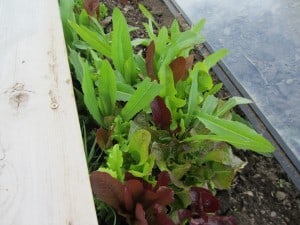
Vegetables and herbs grown or harvested during fall and winter seasons
The vegetables and herbs in the following list can usually be grown or harvested during the fall and winter seasons. Whenever possible, choose a quick-maturing variety.
Also consider your growing structure and the height of each plant, selecting a more compact variety for a short cold frame.
- Arugula
- Beets
- Bok Choi
- Broccoli
- Brussels sprouts
- Cabbage
- Carrots
- Cauliflower
- Chard
- Chervil
- Chives
- Cilantro
- Claytonia
- Collards
- Endive
- Escarole
- Kale
- Kohlrabi
- Leaf Lettuce/Mesclun
- Mâche/corn salad
- Mibuna
- Mizuna
- Mustard
- Oregano
- Pak Choi
- Parsley
- Parsnip
- Peas
- Radicchio
- Radishes (especially Diakon type) – Learn about growing radishes.
- Rosemary
- Sage
- Scallions/Green onions
- Spinach
- Thyme
- Turnips
Most of the plants listed above can be directly sown outdoors or started indoors. However, some prefer a cool germination period.
If your daytime outdoor temperature is above 80 degrees F/ 26 degrees C.
Start the following seedlings indoors
- Arugula
- Broccoli
- Cauliflower
- Chives
- Claytonia
- Kale
- Mâche/corn salad
- Mibuna
- Mizuna
- Mustard
- Oregano
- Radishes
- Sage
- Spinach
- Thyme
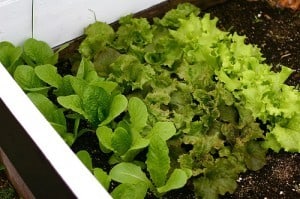
Protective Materials and Structures
When growing fresh veggies in fall and winter, we talked about the basics. Here’s more information on the main types of frost protectors and links to some sources to get you started.
Cloches – How cloches work:
Protect individual plants from light frosts; raise temperature slightly
How to use cloches:
Place over individual plants when frost is expected, remove when temps are above freezing.
Usually placed in the evening and removed in the morning.
Can also be used with early spring plant starts.
Sources of cloches:
Clean glass jars and bowls; plastic jugs and bottles with bottoms removed; manufactured cloches
Mulches – How mulch works:
Insulate plants in ground from freezing temps; maintain moisture in soil
How to use mulch:
Layer thickly on top of mature root and bulb crops.
Sources of mulch:
Compost, straw, deciduous leaves, evergreen needles
How row cover fabrics work:
Insulate plants and soil from frost; raise temperature slightly; protect from insect and bird damage.
Water and sunlight pass through them.
How to use row cover fabrics:
Lay over plants (flat over small seedlings, loosely over tall plants); use over hoop frame. Since they “breathe” they may be used day and night—no need to remove when temps are warm. They can also be used during spring and summer seasons.
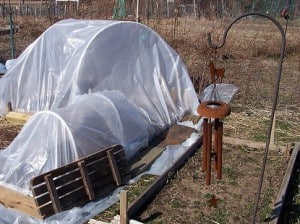
Poly low tunnels and hoops:
Insulate plants and soil from frost; raise temperature; maintain humidity
How to Use Hoops and Tunnels
Install hoop supports and secure poly film over hoops; use drip irrigation on soil or lift cover to water plants.
Leave ends open during cool weather, close ends during frigid weather.
Poly tunnels may be used day and night—no need to remove when temps are warm.
DIY Garden Covers
(Add something here about the value of adding covers)
Use Low Tunnels to Grow Veggies in Winter
How cold frames work
Insulate plants and soil from frost; raise temperature; maintain humidity
How to use cold frames
Construct or purchase cold frame with solid sides and clear glass or plastic cover that can be propped open for temperature and humidity control.
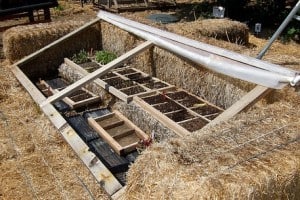
DIY cold frames
Can easily be made with wood, straw bales, other materials and a window or shower door cover.
Make a Cold Frame for Herbs (great cold frame info for veggies too) by Barbara Pleasant at The Herb Companion
Cold Frame Plans (wood) by Betsy Matheson Symanietz at Mother Earth News
A Cold Frame to Build (straw bales) by Paul Gardener at GRIT
Cold Frame Gardening at KitchenGardenerMagazine
How greenhouse high tunnels work:
Sun shines through clear glass, plastic or polycarbonate walls, creating a warm and humid environment for plants. May be heated or unheated.
How to use greenhouse high tunnels
Start seedlings, harden off seedlings started in warmer room, extend production of warm-season plants, overwinter hardy plants.
DIY greenhouse high tunnels
Planning and Building a Greenhouse from Maryland and West Virginia Cooperative Extensions
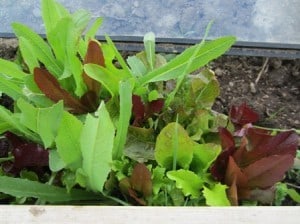
The Benefits of Building a High Tunnel by George Devault at GRIT
Getting Ready for Fall and Winter Gardening
In Part 1 of this series we talked about the basics of growing veggies in cool fall and cold winter temps.
Part 2 was an overview of the materials and structures that protect plants from cold-weather damage.
Today we’re moving toward the planting stage with some more steps to take.
Prepare your soil before planting
If you’re using an existing garden bed for fall and winter plants, it’s a good idea to add some compost before planting.
The summer growing season saps nutrients from the soil and may affect the texture of the soil as well.
Compost will improve the texture and add some nutrients without overloading the soil with fertilizer or requiring decomposition.
When using fresh topsoil or planting mix in a new bed or cold frame, amend as you would for a spring or summer planting season.
This will vary according to the texture and nutrient content of the soil or mix.
If you’d like to test your soil first, use a home kit, local test lab, or a mail-in service such as University of Massachusetts Soil Lab (our favorite–fast and reasonably priced).
Wherever legumes (beans and peas) have grown the previous season, the soil is probably rich in nitrogen, as legume plants actually instill nitrogen in the soil. This is a good location to plant leafy greens.
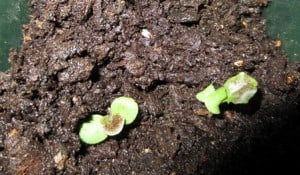
Start seedlings indoors or outdoors
While local stores may not carry seeds in late summer, mail order seed companies usually maintain their ordering and shipping processes throughout the year.
Some seeds are slow to germinate—or won’t sprout at all—when soil is hot.
If your late summer brings heat and scorching sun, it might be easier to start those seeds indoors in a room that’s cooler than the outdoor temps.
Greens and other seeds typically planted in spring fall into this category.
Warmth-loving seeds can be directly sown even in a hot July and August.
Short-season plants may be sown in September as long as the plants will be near maturity by the time cold weather sets in.
Plan protection strategy and get structures ready
In Part 2 of Growing Fresh Veggies in Fall and Winter we talked about several ways to protect plants from frost and cold.
Using two or more together creates opportunity for many combinations as the temperature changes.
Here’s one example of a strategy for plants to be grown through the winter.
Direct sow or transplant into garden bed during late summer.
Leave in garden with row covers during light frosts.
Add poly hoops for heavier frosts.
Move to cold frame or greenhouse to withstand frigid winter temps.
Late summer and early fall are great times to decide how to protect your plants and gather, purchase, or build whatever you need.
Then when a frost is in the forecast, you’ll be ready to cover those plants and keep them alive and happy through the coming months.
See Part 2 for more info and resources.
Mulch root crops
Before heavy frosts arrive, cover mature root crops like carrots and radishes with a thick layer of mulch such as straw, deciduous leaves, or compost.
A layer of row cover cloth over the mulch adds a few more degrees of protection and may prevent mulch from blowing away in the wind.
This is also a good way to winter over perennial herbs and vegetables that will sprout in spring.
In many areas fall is the best time to plant garlic cloves for harvest the following summer.
Garlic likes some time to establish roots and rest for a few months before a growth spurt in the spring.
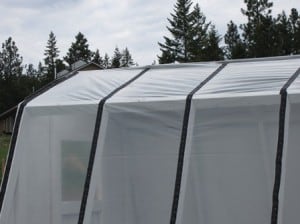
Mulch as for root crops to protect the garlic bulbs from frost damage and disruption from soil heaving during freeze/thaw cycles.
Lay out row cover
Use row cover to protect plants from frost, birds, and insects.
The fabric allows air, water, and light to penetrate.
Row cover may be laid over or under drip irrigation tubes.
Leave fabric slack to allow for plant growth.
Secure at edges and between plants with staples, U-pins, or weights such as rocks or pieces of lumber.
Set up poly hoops
Hoops may be put over row cover for extra insulation.
Secure hoops and poly covers as needed to withstand wind.
Leave ends of poly covering free to be opened on sunny days.
Plan for accessibility for harvest by opening one or both sides of cover.
Clothes pins or heavy clips can be used to attach poly covering to hoops.
Build a high tunnel or greenhouse
Many style and material options are available.
An Internet search for “build high tunnel” or “greenhouse plans” will result in lots of different ideas and schematics.
If locating a structure away from garden, make sure water is easily accessed for watering plants until heavy frosts hit.
A high tunnel or greenhouse normally used in summer may need to be winterized with additional material, doors, or window coverings.
Inside a high tunnel or greenhouse, plants may be grown directly in the ground or in containers.
For extra insulation over plants or around containers, row cover, poly hoops, and cold frames may be used inside high tunnels and greenhouses.
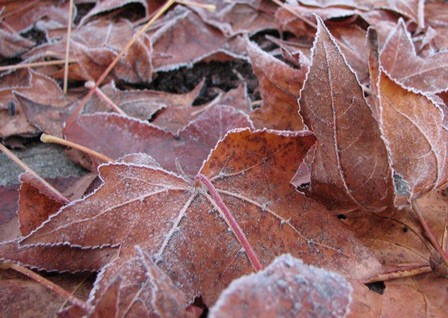
Fall frosts are just around the corner
In some, they have already made an appearance. Time to get those vegetable plants tucked in for the winter!
If you’re just joining our discussion of fall and winter veggies, you might want to start with Growing Fresh Veggies in Fall and Winter Part 1.
Take a few minutes to read Part 2 and Part 3 while you’re at it.
Once you’ve figured out how to protect your plants from the cold, get your system in place.
The next steps depend on your own plans, but here are some ideas.
Put mulch over root vegetables. Several inches of straw or leaves works great.
A layer of row cover or other porous sheeting over the mulch will prevent the material from blowing away while allowing sun and rain to warm and water the soil.
Place row cover over garden plants for defense against light frosts.
Lay it directly over the plants and anchor edges with pins, stones, or pieces of lumber.
Or support the row cover with hoops or another type of framework.
Clothespins, metal binder clips, and other types of clamps will keep the material secure but allow you to open the sides to harvest veggies.
Erect hoops or low tunnels over planted beds and cover with plastic or polyethylene for protection from harder frosts.
Again, clips and clamps are helpful for open-and-close weather protection and harvest access.
Transplant existing plants and seedlings from your garden bed to a cold frame or greenhouse.
This includes herbs and veggies left from summer planting as well as new salad greens started for fall and winter use.
Row cover drapes and hooped plastic can also extend the season for some tender plants that aren’t quite finished producing or ripening by fall.
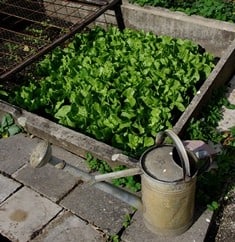
This includes melons and squashes as well as peppers and tomatoes.
Don’t forget to protect your garden from possums and other pests.
Remember these tips
You can quickly build an inexpensive cold frame with four bales of straw and a glass window.
Most plants should be mature by the time heavy frosts arrive.
However, the magic mâche (also known as corn salad) will grow in cold weather as long as it has germinated and gotten a good start in warm soil.
There’s still time to start mâche seeds indoors and transplant them to a cold frame later.
Here’s an idea of what we’re trying out at our farm this fall.
We’re using our main raised bed, which has four sections divided by cross supports.
In two sections, plastic-covered hoops will be put over mature herb plants and some fresh starts of salad greens.
A third section of the raised bed, planted with carrots and radishes, will be mulched with straw and topped with row cover.
The last section of the raised bed contains a fall crop of green peas.
They’ll be covered with hooped row cover and then plastic until the harvest is over.
Then we’ll turn under the pea vines and that area will go fallow for winter, waiting for our earliest spring plantings next year.
Some potted plants will be kept in our new small greenhouse.
It’s unheated but has electricity if we choose to use it.
We’ll keep an eye on things and see how things go this first year.
We want some fresh veggies growing near the kitchen door for easy access, so we’ll use an old storm window and straw bales for a simple cold frame.
We’ll plant a few types of salad greens and herbs there, easy to grab without trudging through the snow.
Using Winter Downtime to Plan for Spring and Summer
The calm before the storm, life on a farm has a rhythm that flows with the seasons.
It’s no surprise that summer is the busiest time of the year.
Demands for tending fields, crops, gardens, and livestock are at their highest in the summer.
Springtime is a transition into that season, and in the fall, those chores begin to wane.
That’s not to say that winter isn’t busy, though.
During the shorter, darker, colder days, livestock that overwinter still need tending.
There is time to plan and repair machinery, clean out barns and sheds, and inventory equipment and supplies.
Of course some of us have other winter employment or year-round jobs that continue like clockwork.
But while summer is the most physically demanding season for a farm family, winter may well be the most taxing on the brain.
In winter, the mail carrier begins to deliver new catalogs and flyers from companies selling seed, equipment, and livestock.
The long evenings allow us to wade through stacks of magazines and books in search of new information and techniques as well as answers to troubling questions.
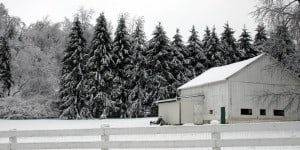
Yes, winter is, among other things, a time for planning.
Right now at our house we are deep in that planning phase.
We have the seed, poultry, and farm supply catalogs out.
Our favorite farming books are next to the recliner.
Our computers are humming as we search websites, read publications, and watch webinars.
We’ve attended a few seminars and workshops sponsored by our local extension office and agricultural center.
We are like sponges soaking up information, yet we also have to step away sometimes and clear our heads.
And for that, there’s nothing like a walk in the crisp cool air with beautiful vistas to enjoy.
For the past two years we have been developing our garden, orchard, and chicken systems.
This year we plan to expand on all of those and add pigs to the mix.
We need to consider our animals in the summer heat as well as in the cold.
We debate whether to start our beef cattle or wait one more year.
Where do we fit in the other infrastructure projects as we continue to develop our acreage?
In addition to what projects to work on, there are personal and ethical decisions to make.
What are our standards and preferences?
Will we focus on heritage livestock breeds and plants, or raise hybrids?
How can we avoid GMO (genetically modified organisms) in our seeds and livestock feeds?
Given our property and resources, what is the best way for us to raise various livestock species and plants?
Yes, it’s a busy time, but we know it’s kind of the calm before the storm.
We won’t be totally ready for it; we never seem to be.
But one thing is for certain:
We’re up for the challenge. Are you?
The Year-Round Vegetable Gardener: How to Grow Your Own Food 365 Days A Year No Matter Where You Live
Fresh salads from the garden in December?
Even in our four-season climate, where snow often covers the frozen soil all winter long?
Yes—it’s true—we can have our lettuce and eat it too!
We have never tried growing veggies all year round—but we are going to give it a go!
During the next two months we’ll be featuring some blog posts about fall and winter vegetable gardening.
To introduce the topic, here’s a review of an awesome book that we were glad to discover.
Author Niki Jabbour is a seasoned (no pun intended) gardener who not only raises food for her family but also loves to encourage others to do so.
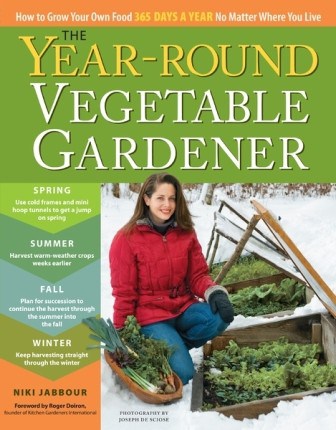
She has written articles for numerous gardening magazines and currently hosts a radio show called “The Weekend Gardener.”The Year-Round Vegetable Gardener<
As its title implies, this book is about gardening year-round, not just fall and winter gardening.
There is some great general info on gardening basics, including garden design, soil building, and succession planting.
Profiles of 43 different vegetables and 10 herbs
Provide growing and harvesting guidelines as well as Niki’s Picks—lists of the author’s favorite tried and true varieties.
A planting calendar for each plant indicates when to start seedlings indoors and sow directly outdoors, including multiple sowing times for successive and year-round crops.
Did you think your area had just one growing season?
“Stretching the Seasons” introduces us to the three growing seasons
Cool (spring and autumn), warm (summer) and cold (winter).
The author shares the keys to nonstop crops, among them soil amendments, cover crops, succession sowing, and interplanting.
We learn how changing day lengths and frost dates affect the growing seasons throughout the year.
In “Designing Productive Gardens,” the author explains how to select a site and plan out a garden that will span the seasons.
Both perpetual patches and crop rotations are discussed.
Several year-round garden designs are described and delightfully sketched (kudos to illustrator Elara Tanguy).
Throughout the book are sidebars and highlight pages featuring interesting gardeners and growing techniques.
Colorful photos, diagrams, and charts provide bright illustrations of the information and techniques featured in the text.
This book does double duty as a gardener’s reference manual and a coffee table book for dreaming and feasting with the eyes.
As you may have gathered, we were especially intrigued by the concept of raising fresh vegetables even under a blanket of snow.
The book’s cover indicates right off that this is a possibility.
The author is photographed bundled in a parka, kneeling in the snow at her cold frames with a harvest of very fresh goodness for her kitchen.
Niki Jabbour lives in Nova Scotia, so she knows true winters.
And she raises fresh vegetables all year long, so she knows it can be done.
What’s more, she guides us through the process so we too can eat garden salads in the midst of winter.
A chapter titled “Growing into Winter” suggests numerous micro-environments for growing fresh vegetables in fall and winter.
Mulches, row covers, hoops, cloches and hot caps will extend the harvest of summer crops into fall or winter.
Cold frames, heated greenhouses, and poly tunnels can protect plants even in the middle of winter, sometimes yielding fresh vegetables all the way into spring.
A combination of two or more of these will provide even more insulation from the frigid temps of winter.
Wondering what all those materials and structures are?
Just peruse the pages of this book and you’ll see descriptions, options, and construction details.
All accompanied by those wonderful photos and sketches.
Our detailed research for fall and winter gardening included some time spent in Part 2, “Growing the Right Crops.”
That’s where all those wonderful plant profiles are found.
A snowflake symbol indicates which veggies and herbs are good candidates for winter gardening.
Growing descriptions also detail those summer crops that can be extended into fall.
Our conclusion: The Year-Round Vegetable Gardener delivers what its title suggests, guiding the reader through a full year of growing, harvesting, and enjoying fresh veggies.
No Matter Where You Live, you’ll learn How to Grow Your Own Food 365 Days a Year.
A warning from author Niki:
“In this book, I’ll walk you through the process of creating a year-round vegetable garden.
But it’s only fair to warn you that the ability to harvest fresh, organic vegetables year-round from your own garden is potentially addictive.
It’s extremely satisfying, though, and easier than you might think. Interested?”
We sure are!
And we’re feeling ready to jump in.
How about you?
Homegrown Herbs: A Complete Guide to Growing, Using, and Enjoying More than 100 Herbs By Tammi Hartung
For many years we’ve grown veggies with only a few herb plants scattered in the garden.
Last year we made a point of planting several of our favorite herbs.
We really enjoyed having our own fresh and dried herbs available for cooking for much of the year.
So from now on, we’ll be planting more varieties and larger quantities of flavorful and fragrant herbs to enjoy fresh, frozen, dehydrated, and canned with other foods.
We discovered a treasure chest of information, not only on growing herbs but also about using them in the home and kitchen.
Homegrown Herbs: A Complete Guide to Growing, Using, and Enjoying More than 100 Herbs
First off we noticed that the book is not just about herbs.
With its general gardening info, Homegrown Herbs could actually serve as a basic gardening handbook.
Concepts and techniques such as plant selection, soil amendment, propagation, and control of pests and diseases are covered.
Specific culture of plenty of herbs is included.
All one would need is additional details on vegetables, flowers, and fruit.
Garden design suggestions are illustrated by sketches of herb gardens from a formal knot to a chef’s retreat to an apothecary garden.
Ideas for herb theme collections include culinary, children’s, tea, medicinal, and wildlife gardens.
Get the most Flavor from Your Garden with Herb and Spices to Plant with Vegetables.
But speaking of herbs…
We found lots of details about culture, harvest, seed saving, and processing of herbs.
Kitchen and household use includes some luscious-looking recipes for meals, snacks and beverages using both cultivated and wild herbs.
But that’s not all—there are recipes for pest control preparations, health and personal care products, and herbal vinegars.
A wonderful “personality” section covering the characteristics and need of 100 individual herbs goes beyond the basic parsley, sage, rosemary, and thyme.
Though the most common herbs are included, also featured are some herbs we’d never even heard of before.
Costmary, skullcap, and yerba mansa are all new to us!
Also included are some plants we’d never considered to be herbs: ginger, hops, and sunflowers for instance. Who knew?
Winter Doesn’t Mean Gardening Has to Stop
But that doesn’t mean the fresh veggie season has to end!
With special care, we can extend the harvest of summer crops. And what’s more, many greens and other veggies can be grown through the fall and winter, providing fresh produce even on the snowiest of days.
See our list of suggested plants below. Within each plant group, some varieties thrive better than others in frigid temps. This is a wonderful way to enjoy fresh produce during fall and winter.
Learn when to harvest beets to optimize flavor.
Resources:
- Scientific names for plants
- Soil temperatures for planting
- Growing cool season crops
- Temperatures for planting

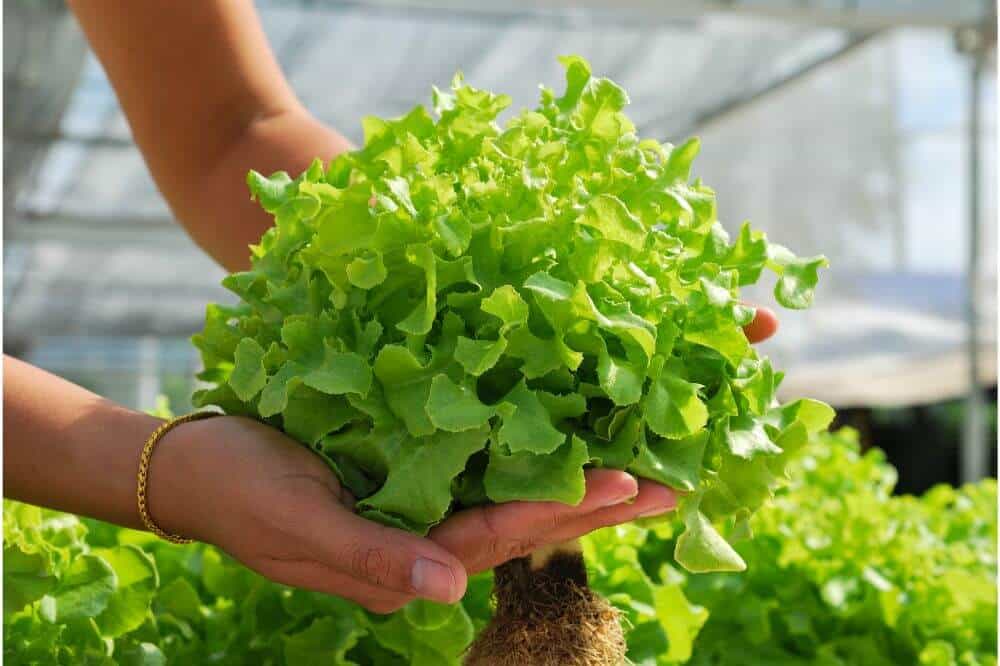
I look forward to receiving Rural Living Today – So much great information from people who really live the rural life. Thanks so much!
Thanks for sharing all the great gardening articles with Wildcrafting Wednesday!
Glad you shared your post on the HomeAcre Hop, looks like a great collection of gardening articles. Hope to see you again this Thursday! Nancy
HomeAcre Hop